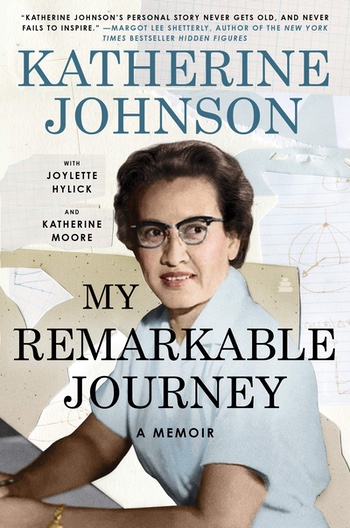Review: My Remarkable Journeyby Jeff Foust
|
| A series math classes taught by one professor, she said, “stretched my mind farther that I ever believed possible.” That professor convinced her that she make a career in mathematics. |
Nelson went on to tell the story, made famous by the book and movie, of Johnson being asked to check by hand the calculations an electronic computer made for John Glenn’s historic orbital spaceflight, reportedly at the request of Glenn himself. The calculations checked out, and the rest was history, even if it took a half-century for the public to know her role.
If people know Johnson, who passed way in February of last year at the age of 101, it’s for the portrayal of her in the movie, be it checking the math for Glenn’s flight or having to walk across the campus of the Langley Research Center to find a restroom she, as a Black woman, could use. But that was just one small chapter of a memorable life that took her from small towns in West Virginia to NASA and late-in-life fame.
That life lives up to the title of Johnson’s memoir, My Remarkable Journey, which she started before her death and which her two daughters, Joylette Hylick and Katherine Moore, completed. Johnson tells, in her own words, her life story, beginning with the Hidden Figures fame that included an appearance at the Oscars before going back to her childhood.
Space didn’t play a role in her modest childhood, and even for a time mathematics did not: she originally envisioned majoring in French at West Virginia State College. But a series math classes taught by one professor, W.W. Schieffelein Claytor, “stretched my mind farther that I ever believed possible.” That professor convinced her that she make a career in mathematics.
But becoming a research mathematician was difficult for a Black woman just graduating from college during the Great Depression. Instead, she found jobs as a teacher, married and started a family, and moved from town to town Virginia and West Virginia. By the 1950s, that led her to Hampton, Virginia, where her husband—who would die of a brain tumor several years later—got a job in the Newport News Shipyards. She landed a job at NASA’s predecessor, NACA, as part of the pool of women who did calculations in an era when a computer was a job title, not a piece of hardware.
| “How many Katherine Johnsons have we missed over the years?” Manchin asked. |
Her work at Langley is well documented in Hidden Figures, both the book and movie, but Johnson in her memoir goes beyond her role in supporting Glenn’s flight. She remained at NASA until 1986, transitioning to human computer to programmer of electronic computers, working on programs ranging from Apollo to Space Station Freedom. She also remarried and saw her daughters grow up in the midst of the civil rights movements of the 1960s.
Johnson’s life is without a doubt a remarkable journey, one that that we’re fortunately to know thanks to Hidden Figures as well as her own memoir. It is a life well lived, both personally and professionally, one that overcame adversity and tragedy to make the world a better place.
At the Senate hearing last week, Manchin mentioned he had a chance to meet Johnson in 2018, and later was a lead sponsor of the legislation directing NASA to rename its West Virginia facility after her. He also suggested that the agency needed to do more to help those from disadvantaged backgrounds. “How many Katherine Johnsons have we missed over the years?” he asked. NASA may have missed a lot of a talent, but Katherine Johnson was one of a kind.
Note: we are using a new commenting system, which may require you to create a new account.
